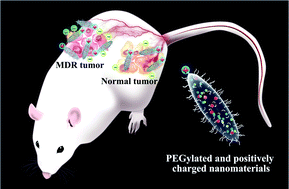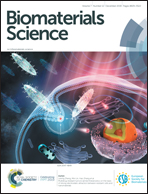Multidrug resistant tumors-aimed theranostics on the basis of strong electrostatic attraction between resistant cells and nanomaterials†
Abstract
Chemotherapy is one of the most common and effective ways for the clinical treatment of tumors, but tumor cells develop resistance toward drugs after a long period of chemotherapy. Interestingly, the gene expression of resistant cells usually generates increased sialic acid and raises the negative potential of the cell membranes, which is potentially useful to design novel theranostic models. In this work, we demonstrate multidrug resistant tumors-aimed theranostics by the virtue of the strong electrostatic attraction between resistant cells and nanomaterials. Human oral epithelial carcinoma vincristine-resistant tumor (KBV) and human oral epithelial carcinoma tumor (KB) were employed and compared as the tumor models. Polyethylene glycol-coated and Cu(II) and vincristine codoped polyaniline nanoshuttles (VCR-PEG-CuPani NSs), which possessed multifunctions, positive charges, and blood circulation half-life of 6.26 ± 0.16 h, were employed as the nanomaterials for performing the tumor theranostics. Because of the stronger electrostatic attraction with KBV than that with KB, VCR-PEG-CuPani NSs showed higher enrichment of 8.05 ± 0.39% ID g−1 for KBV and a lower value of 6.02 ± 0.22% ID g−1 for KB. The higher accumulation of VCR-PEG-CuPani NSs in KBV tumors further improved the efficacy of tumor theranostics, such as those using magnetic resonance imaging, chemotherapy, and photothermal therapy.



 Please wait while we load your content...
Please wait while we load your content...